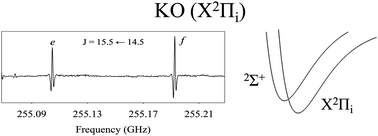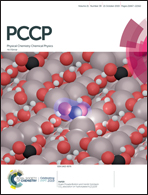The ground state of KO revisited: the millimeter and submillimeter spectrum of potassium oxide
Abstract
The millimeter/sub-millimeter spectrum of the KO radical has been recorded in the frequency range 90–534 GHz using direct absorption methods. The radical was synthesized by reacting potassium vapor, produced with a Broida-type oven, with either N2O or O2 mixed in argon carrier gas. Twenty-seven rotational transitions of KO were measured, each exhibiting a doublet structure with a relatively small splitting (∼100–200 MHz) that increased noticeably with frequency. A perturbation was apparent in the rotational lines at energies above ∼120 cm−1, which was more prominent in one doublet component. The data were successfully fit with a Hund's case (c) Hamiltonian, assuming that spectra arise from a 2Πi state, and rotational and effective lambda-doubling constants were determined. Higher order centrifugal distortion terms were needed to account for the perturbation. The spectra could also be fit as a 2Σ+ ground state, but less successfully, and the resulting rotational constant of B = 8235.4 MHz disagreed significantly with that predicted by theory. On the basis of the experimental data, the ground electronic state of KO has been assigned as 2Πi, although the 2Σ+ assignment cannot be entirely ruled out.



 Please wait while we load your content...
Please wait while we load your content...
